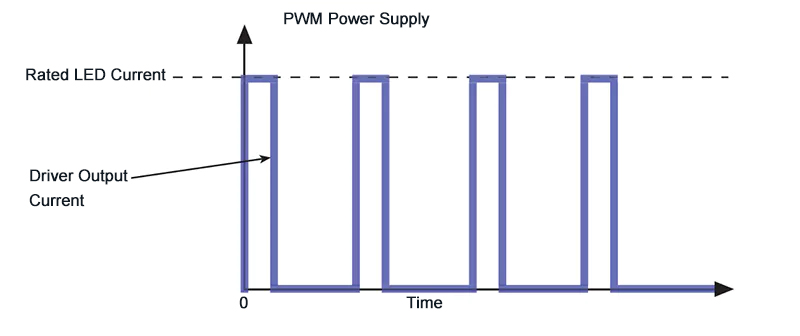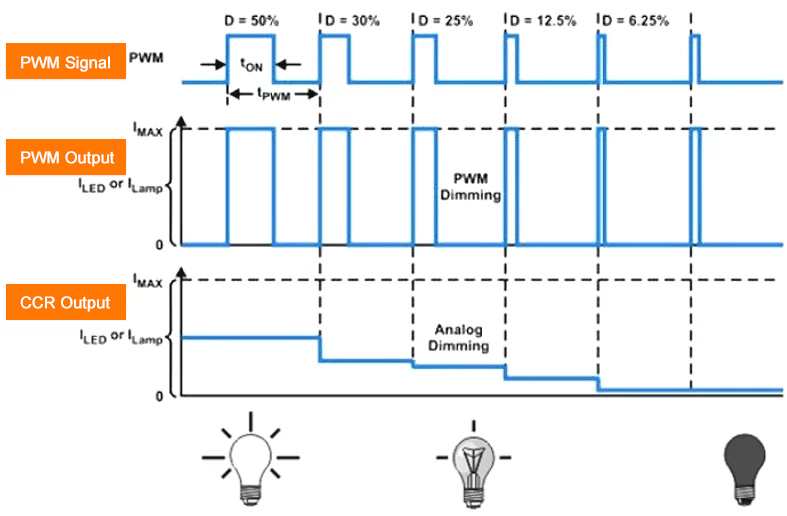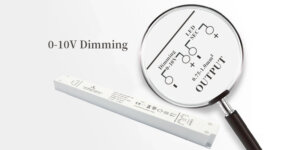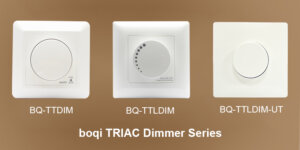パルス幅変調(PWM)調光は、LEDの輝度制御によく使われる技術です。PWM調光は、その効率性と正確な調光制御が可能なことから、広く使われています。この記事では、PWM調光について、その利点、技術的な詳細、他の調光方法との比較について説明します。
LEDドライバーのPWM調光は、パルス幅変調を使用します。これは、LEDを高い周波数でオン・オフすることにより、LEDの明るさを調整するものです。デューティサイクルを変化させることで、LEDに供給される平均電力を変化させ、明るさを制御します。PWM調光は、その効率の良さから好まれている。LEDの明るさを正確に制御できる。そのため、多くの照明用途に適しています。
PWM調光をよりよく理解するためには、それがどのように機能するのか、なぜ他の方法よりもPWM調光が好まれるのか、その詳細を掘り下げる必要がある。
調光に関する洞察

定電流低減(CCR)
LEDは様々な方法で調光することができます。最も一般的なものは定電流減光(CCR)とパルス幅変調(PWM)である。CCRはLEDに供給される電流を減らし、それによって輝度を下げます。この方法は簡単である。しかし、LEDの色や効率が変わる可能性がある。電流を下げると、CCRによってLEDの色が変わったり、輝度が落ちたりする可能性がある。また、この方法はより多くの熱を発生させるかもしれない。この熱はLED部品の寿命を縮める可能性がある。

定電流化は次のような分野で応用されている。
- ドライバーと電源が離れている場合
- 湿気の多い場所や屋外での使用
- 電磁干渉(EMI)基準の厳しい地域
パルス幅変調(PWM)
一方、PWM調光は、LEDのオン・オフを素早く切り替えることで明るさを制御する。LEDに供給される平均電力は、PWM信号のデューティ・サイクルを変えることで調整される。この方法は色の一貫性を維持し、より効率的であるため、多くの用途で好まれています。PWMはパルス幅を変調します。これにより、LEDは安定した電力を短時間で得ることができます。これにより、LEDはその色を維持することができます。また、PWMはデジタル・システムで簡単に制御できます。このため、最新の電子制御やスマート照明システムとの高い互換性があります。
PWMは以下の分野で応用されている。
- LEDドライバー調光
- ソーラーパネル
- モーター
PWM調光とは?
PWM調光は、LEDに供給される電力を制御するために矩形波信号を使用する。信号は高い周波数でオンとオフの状態を切り替えます。デューティ・サイクルとは、信号がオンである時間の割合である。これによって平均電力が決まり、LEDの輝度が決まる。例えば、デューティ・サイクルを50%に設定すると、LEDは半分の時間オン、残りの半分の時間オフとなり、50%の明るさになる。オンとオフの切り替えが速い。人間の目には、光の明滅ではなく、調光効果として見えます。
例えば、50%のデューティ・サイクルは、LEDが半分の時間点灯し、残りの半分が消灯することを意味し、50%の明るさになります。デューティサイクルを調整することで、輝度を正確に制御することができます。さらに、PWM調光は単純なオン・オフ・パターンに限定されない。デューティ・サイクルを滑らかに変化させることができます。これにより、明るさを徐々に変化させることができます。これは、スムーズな調光が必要な用途に有効です。例えば、建築照明や舞台照明などである。また、マイコンはPWM調光を実装できる。このため、さまざまなLEDドライバーの設計に汎用的に使用できます。

LEDの調光にPWMが使われる理由
PWMがLEDの調光に使われるのは、いくつかの利点があるからだ:
– 効率性:PWM調光は電力を熱として放散しないため、エネルギー効率が高い。アナログ調光方式は、余分な電力を熱にしてエネルギーを浪費する可能性があります。PWMはより正確に電力を制御します。エネルギー損失を最小限に抑えます。このスピードは、バッテリーを使用する照明やポータブル照明では重要なカギとなります。電力を節約することは非常に重要です。
– 精密:輝度レベルを正確にコントロールできます。デューティサイクルを微調整できるため、非常に暗い状態からフル輝度まで、幅広い輝度設定が可能です。この精度により、PWM調光は、医療機器、写真照明、ディスプレイのバックライトなど、正確な照明制御が不可欠なアプリケーションに適しています。
– 一貫性:LEDライトの色温度と品質を維持します。LEDは「点灯」期間中、常に定格電流で動作しているため、色温度は安定しています。これは、電流レベルが低いと色ずれが生じるアナログ調光に比べて大きな利点です。小売店の照明や博物館のディスプレイのような用途では、一貫した色の品質が不可欠です。このような場所では、正確な色が非常に重要です。
– 互換性:デジタル制御装置やマイクロコントローラーと簡単に統合できる。多くのデジタル機器はPWM信号を作ることができる。これらのデバイスには、マイクロコントローラー、PLC、そして単純なタイマーも含まれます。この互換性により、スマート照明システムや自動制御セットアップに簡単に統合でき、リモート調光制御、プログラム可能な照明スケジュール、ダイナミックな照明効果などの機能が可能になります。
これらの利点により、PWMは理想的なアプリケーションとなっている。その用途は、家庭用照明から産業用、自動車用まで多岐にわたる。例えば自動車では、PWM調光はダッシュボードやヘッドライトの調光に使われています。また、室内のアンビエント照明にも使われている。変化する条件下で、信頼性が高く効率的な制御を実現します。
LEDドライバにおけるPWM調光の仕組みに関する技術的詳細
LEDドライバーのPWM調光では、高周波の矩形波信号を生成する。この信号はLEDドライバに供給され、LEDドライバはPWM信号のデューティ・サイクルに基づいてLEDに供給される電力を調整する。LEDドライバーは仲介役として機能し、LEDが希望する明るさを達成するために適切な量の電力を受け取ることを保証する。変調プロセスでは、LEDへの電流を高速でオン・オフする。オン」時間の長さは、PWM信号のデューティ・サイクルによって設定される。
LEDドライバーは通常、PWM信号を生成するマイクロコントローラーまたは専用のPWMコントローラーICを含む。PWM信号の周波数は、目に見えるちらつきを避けるために十分に高く、通常は200Hz以上に選ばれる。この周波数では、オン・オフの遷移が速すぎて人間の目では検出できないため、滑らかな調光効果が得られます。マイクロコントローラーまたはPWMコントローラーICがデューティーサイクルを調整する。これは、ユーザー入力またはプログラムされた設定に基づいて行われます。これにより、ダイナミックで応答性の高いLED輝度制御が可能になります。
信頼できる性能を保証するために、LEDドライバはLED負荷の特定の特性を扱うように設計されなければなりません。これにはLEDの順方向電圧が含まれます。また、定格電流や熱的ニーズも含まれます。ドライバーにはフィードバック機能があります。これはLEDの性能をモニターし、PWM信号を調整します。これにより、さまざまな条件下でも明るさと色が一定に保たれます。また、LEDドライバには保護機能が付いている場合があります。過電流保護、サーマルシャットダウン、短絡保護などである。これらはLEDとドライバー回路の両方を保護します。
調光信号としてのPWM:デューティ・サイクルと周波数
PWM信号のデューティ・サイクルとは、信号の全周期に対するオン時間の比率である。例えば、デューティ・サイクル25%は、信号が25%の間オンで、75%の間オフであることを意味する。デューティ・サイクルを調整することで、LEDに供給される平均電力が変化し、輝度が制御される。デューティ・サイクルの柔軟性により、幅広い輝度レベルが可能になる。ほぼオフから完全にオンまで対応します。正確でスムーズな調光制御が可能です。


PWM信号の周波数も重要だ。周波数が高いほど調光はスムーズになり、ちらつきが回避される。これは、ビデオ録画のような動きのあるアプリケーションで特に当てはまります。フリッカーのない調光には、25 kHz以上の周波数が推奨されます。このような高い周波数では、PWM信号のオンとオフが非常に速く切り替わります。このフリッカーは非常に速いため、人間や高速度カメラには見えません。これはプロの照明セットアップでは重要なポイントです。フリッカーは、映像の品質や視聴者の快適性を損ないます。

実際には、PWM周波数の選択は、LEDのニーズとその使用ケースに依存する。例えば、建築照明の場合、目に見えるちらつきを避けるには1kHz程度の周波数で十分かもしれない。しかし、高性能ビデオ照明では、完璧な性能を得るために25 kHz以上の周波数が必要になる場合があります。デューティ・サイクルと周波数は慎重に調整する必要があります。明るさ、効率、ちらつきのない動作のバランスをとるためです。要素としては、LEDの応答時間やシステムの熱特性などがある。
LEDドライバ出力としてのPWM
PWMベースのLEDドライバでは、出力はPWM信号に対応する変調された電流である。LEDドライバーは、PWM信号を対応する電流に変換し、LEDを駆動します。この方法により、LEDは適切な量の電流を得ることができます。これにより、明るさと効率が保たれます。電流を変調することで、LEDの光出力を正確に制御することができます。これにより、幅広い輝度レベルにわたって安定した性能が保証されます。
LEDドライバは、PWM信号に同期してLEDへの電流をオン・オフで高速に切り替えることでこれを実現している。オン」期間中、LEDは全電流を受け取り、最大光出力を生成します。オフ」期間には、LEDは電流を受け取らず、光出力は得られません。ドライバは、「オン」期間と「オフ」期間の比率(デューティ・サイクル)を調整します。この制御により、平均電流が設定され、LEDの平均光出力が設定されます。

この方法にはいくつかの利点がある。第一に、「オン」期間中、LEDをフル効率で動作させることができ、エネルギー損失と発熱を最小限に抑えることができる。第二に、「オン」期間中、LEDは常に定格電流で動作するため、LEDの色の一貫性が維持される。第三に、LEDの明るさを正確に制御できます。これにより、スムーズな調光とダイナミックな照明効果が可能になります。また、PWMベースのドライバーは、デジタル制御システムに簡単に接続できます。これにより、照明設定をプログラマブルに遠隔制御することができます。
PWM調光と他の調光方式との比較
PWM調光には、他の方式に比べていくつかの利点がある:
– アナログ調光:LEDに供給する電流を調整する。シンプルだが、色ずれが生じやすく、効率も悪い。アナログ調光は、電流を徐々に減少させる。このため、LEDの発光強度が変化したり、色が変わったりする可能性がある。また、この方法では、より多くの電力を熱として放散する傾向があり、システム全体の効率が低下する。
– 位相カット調光:AC電源のLEDドライバに使用され、AC波形をチョップして電力を削減する。LEDドライバによっては、ちらつきや互換性の問題を引き起こすことがある。フェーズカット調光は、AC波形の一部をカットすることで機能し、LEDに供給される平均電力を効果的に削減する。この方式は、一部のLEDドライバーとの互換性の問題を引き起こす可能性がある。これは、ちらつきや性能低下につながる。また、実装により複雑な回路を必要とするため、照明システムのコストと複雑さが増す可能性があります。
PWM調光はより効率的です。また、正確な制御が可能で、色も一定に保たれます。多くの用途でより優れています。PWM調光は高周波信号で電力を変調します。アナログ調光や位相カット調光の問題を回避できます。PWM調光は、より信頼性が高く、柔軟なソリューションです。また、PWM調光はデジタル制御システムで動作します。プログラム可能な調光プロファイル、遠隔操作、スマートホームシステムとの統合など、高度な機能を実現します。
市場におけるPWM調光ドライバの実現
PWM調光ドライバは、LED照明においてますます重要になってきている。しかし、PWM調光ドライバーの実装には2つの異なる方法があることを理解することが重要です。これらの方法を探ってみよう。
フェイクPWM調光
偽PWM調光方式では、PWM入力をアナログ制御信号に変換する。この方法では、ドライバ内に抵抗コンデンサ(RC)フィルタを使用する。RCフィルターはPWM信号を平滑化し、デューティ・サイクルに比例したDC電圧に変換する。偽PWM調光の利点の1つは、LED電流が出力で連続的なままであるため、ノイズがないことである。

しかし、この方法には大きな欠点がある。精度を確保するためにはPWM信号のピーク値を10Vにしなければならず、これが制約となる。また、RCパラメーターはPWM信号の周波数を制限する。これは調光システムの柔軟性と性能を低下させる。
リアルPWM調光
実際のPWM調光では、LED電流は指定された周波数とデューティ・サイクルでオン・オフを切り替える。ドライバー内部のマイクロコントローラー(MCU)がPWM信号のピーク電圧を検出し、正確な制御を可能にします。リアルPWM調光は、より幅広いPWM周波数をサポートし、LED出力の白色点を維持します。また、より高い基準電圧に対応し、オフセット誤差を低減します。

例えば、すべてのboqiドライバーは、真のPWM調光を容易にするためにMCUを内蔵しています。これにより、同社のドライバーは3.8Vから10Vまでの幅広いPWM信号電圧を受け入れることができ、一般的に使用されている5V PWM信号など、さまざまなPWM信号に対応することができます。

この機能を利用するには、ドライバ・プログラミング・ソフトウェアでPWM調光モードを選択する必要がある。
結論
結論として、PWM調光はLEDの輝度を制御するための効果的で効率的な方法である。その精度と適応性により、様々な用途で好まれている。その仕組みと利点を理解することは、ニーズに合った調光ソリューションを選択する際に役立ちます。boqiのような信頼できるプロバイダーをお選びください。高品質の 調光LEDドライバー.このドライバーは卓越した性能と信頼性を提供する。






